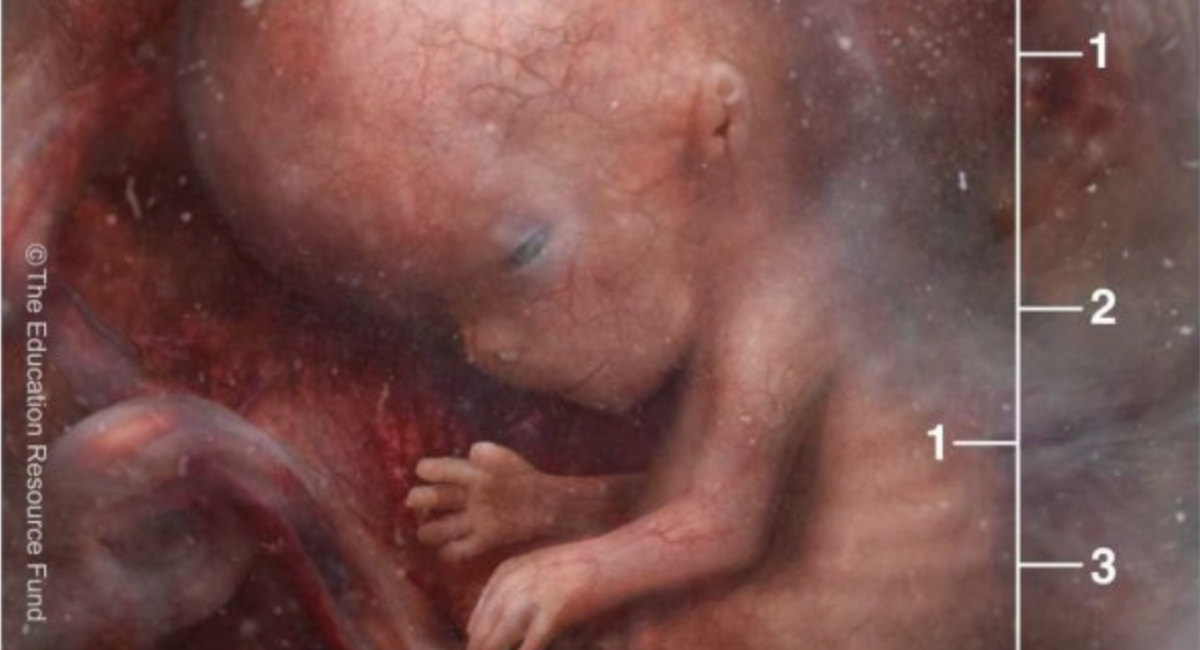The American College of Obstetricians and Gynecologists (ACOG) quietly updated its “Guide to Language and Abortion” to once again redefine when a preborn child’s heartbeat begins.
Last year, the heavily pro-abortion organization claimed detection of “fetal cardiac development” (as ACOG puts it) occurred from “17 to 20 weeks” but the group’s updated document now defines this as “a gradual process that continues through a pregnancy.”
ACOG failed to publicly announce the changes, despite the definition being cited by news media (NBCNews, PBS, Reuters, DesMoines Register, The Oklahoman and others) as well as various court cases.
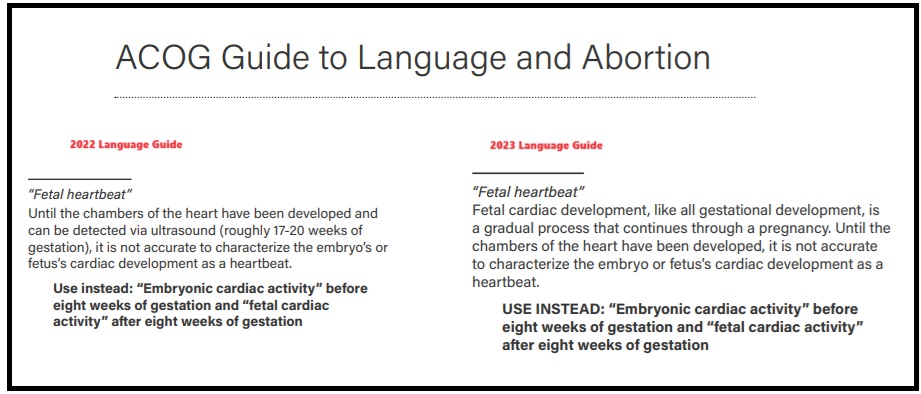
ACOG fetal heartbeat info in Language Guide to Abortion changed 2022-23
Christopher Mills at National Review Online caught ACOG’s language guide update after reviewing a Planned Parenthood court document challenging South Carolina’s Fetal Heartbeat Act (S.B. 474). The law defined fetal heartbeat as “cardiac activity” which “begins at a biologically identifiable moment in time, normally when the fetal heart is formed in the gestational sac.”
Mills pointed out how “Planned Parenthood has relied on the American College of Obstetricians and Gynecologists (ACOG), whose ‘Guide to Language and Abortion’ and many amicus briefs said that ‘a fetal heartbeat exists only after the chambers of the heart have developed and can be detected via ultrasound, which typically occurs around 17 to 20 weeks’ gestation.'”
“Thus, said ACOG, ‘there is no recognizable ‘heartbeat’ from a clinical perspective,’ and ‘[w]hat pregnant [women] may hear is the ultrasound machine translating electronic impulses that signify fetal cardiac activity.’ ACOG said this to courts over and over and over and over and over and over,” Mills wrote.
Planned Parenthood Distances Itself from ACOG’s Fetal Heartbeat Definition
According to footnotes cited (page 5) in the Planned Parenthood heartbeat lawsuit, the abortion corporation is distancing itself from ACOG’s outdated definition. The footnote read in part:
Physicians and scientists may use different verbiage in talking about cardiac development. For example, some may use the term ‘heartbeat’ to refer to early embryonic electrical activity. However, the medical consensus is that the four main components of a heart (four chambers, walls, valves, and conduction system) form after approximately nine weeks LMP…
Petitioners use the term ‘after approximately nine weeks LMP’ as a conservative estimate of when the heart has formed, acknowledging that heart development can continue to ten weeks LMP, consistent with the State’s materials.
This is a stunning change from once supporting ACOG’s stance of a 17-20 week heartbeat to stating that 9-10 weeks is when there is cardiac activity of a four-chambered heart (though it should be noted that the heart is pumping blood through the embryo’s body weeks before it has four chambers).
“In their petition for rehearing in Planned Parenthood II, Petitioners cited an amicus brief submitted by the American College of Obstetricians and Gynecologists, the American Medical Association, and the Society for Maternal-Fetal Medicine for the proposition that ‘a true fetal heartbeat exists only after the chambers of the heart have been developed and can be detected via ultrasound, which typically occurs around 17–20 weeks’ gestation [(LMP)]…'” Planned Parenthood wrote.
The footnote stated (emphasis added):
After consulting with experts, Petitioners [Planned Parenthood] understand that a heart forms earlier than that, but that an ultrasound will not be able to detect the essential features of a heart until later….
Some highly sophisticated technology will be able to detect the four chambers of the heart as early as twelve weeks (typically performed for patients with high-risk pregnancies), and an echocardiogram (also for patients with high-risk pregnancies) performed at 18–20 weeks LMP allows for an even more detailed visualization of the heart…
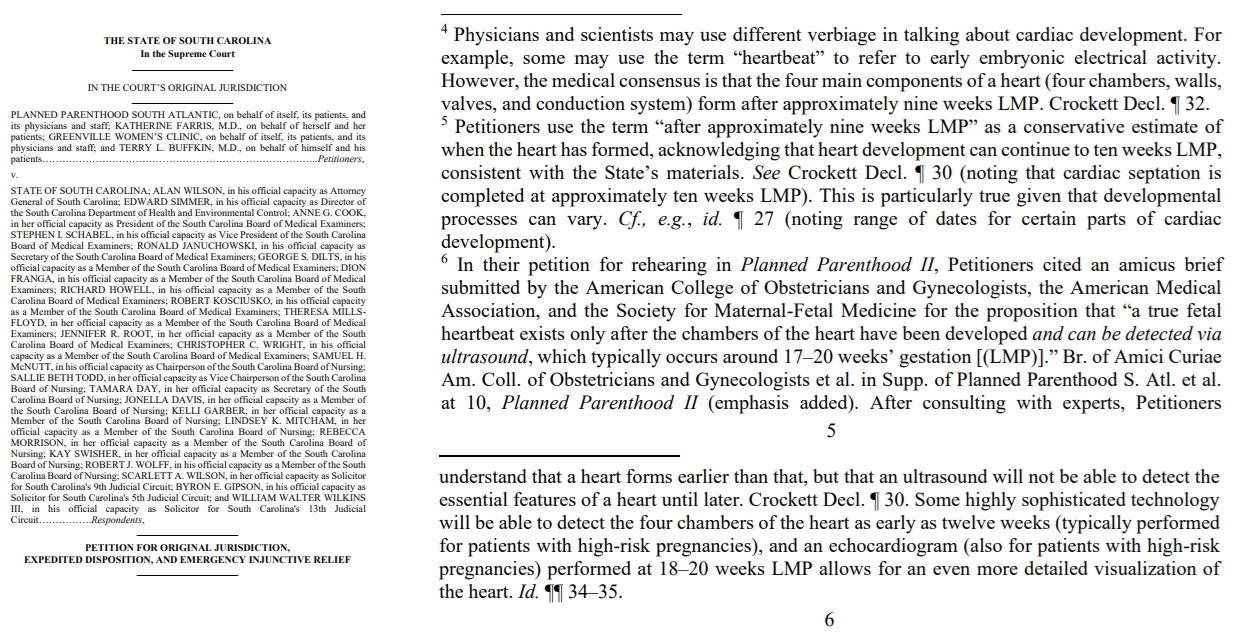
South Carolina lawsuit by Planned Parenthood footnotes on fetal heartbeat
Planned Parenthood’s Ever-Changing Language on Embryonic Heartbeats
While Planned Parenthood admitted in the lawsuit that a preborn human being’s heart develops sooner than ACOG had previously claimed, the abortion corporation has had its own issues with changing definitions in past years.
On June 24, 2022, the week the U.S. Supreme Court overturned the infamous Roe v. Wade decision on abortion, Planned Parenthood’s website claimed that, at 5-6 weeks, “A very basic beating heart and circulatory system develop.” Planned Parenthood then added that at 7-8 weeks that “The heart has formed.”
This language was present on Planned Parenthood’s website — with no apparent issues — in 2015 and was even there as far back as 2009.
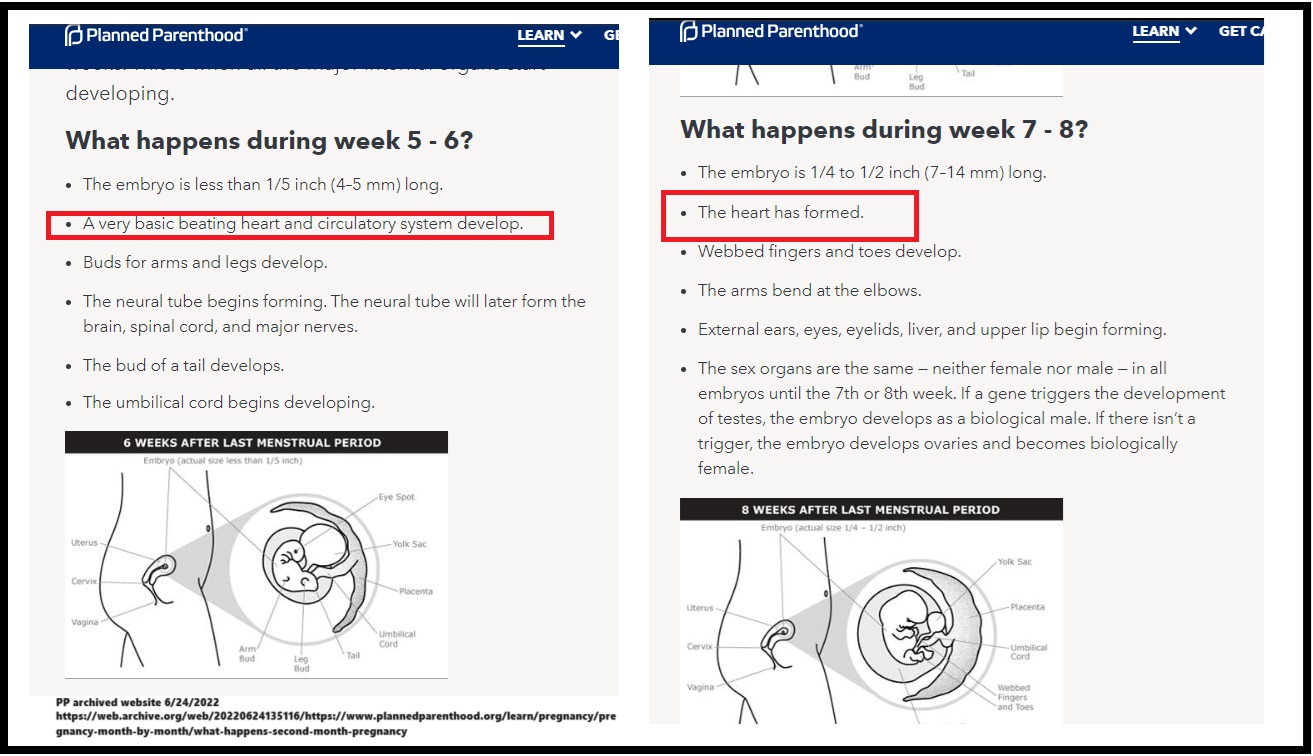
Planned Parenthood fetal development website 5-6 weeks fetal heartbeat 06242022
Currently Planned Parenthood has claimed on its fetal development website page that at 5-6 weeks, “A part of the embryo starts to show cardiac activity. It sounds like a heartbeat on an ultrasound, but it’s not a fully-formed heart — it’s the earliest stage of the heart developing.”
The website then added that at 7-8 weeks that “The heart forms.”
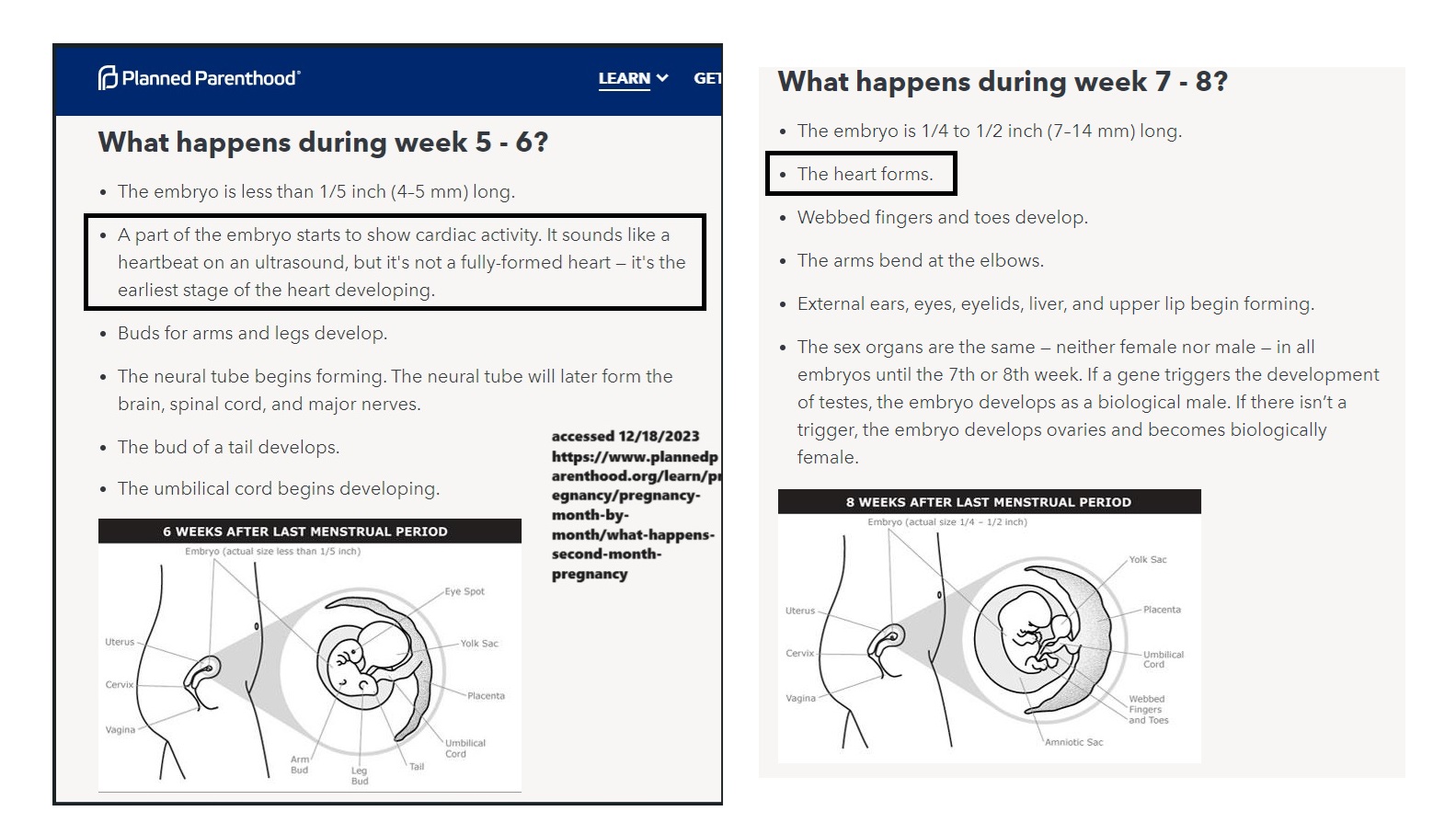
Planned Parenthood fetal development 5-6 weeks fetal heartbeat 12182023
Timeline of ACOG’s Changes on Fetal Heartbeat
ACOG, which was led to its abortion advocacy by population control eugenicists, has made it their mission to oppose pro-life fetal heartbeat laws, insisting upon using terms like “embryonic pulsing,” and “fetal pole cardiac activity” instead of “heartbeat,” describing the embryo’s heart as “pulsing cells” or even “vibrations.”
And due to ACOG’s willingness to partner with Big Abortion and coach the media on how to weaponize language to dehumanize children in the womb, ACOG’s website and published reports have been through multiple revisions, as documented below.
2011: ACOG published FAQ156, “How Your Baby Grows During Pregnancy,” which not only documented that life begins at the moment of fertilization but that a preborn human’s heartbeat begins near the end of the first month of pregnancy.
This ACOG document claimed that in the first month of pregnancy, “The heart and lungs begin to develop. The heart begins to beat near the end of this month,” the ACOG document claimed.
But apparently that document was incorrect, according to ACOG’s ever-changing definitions.
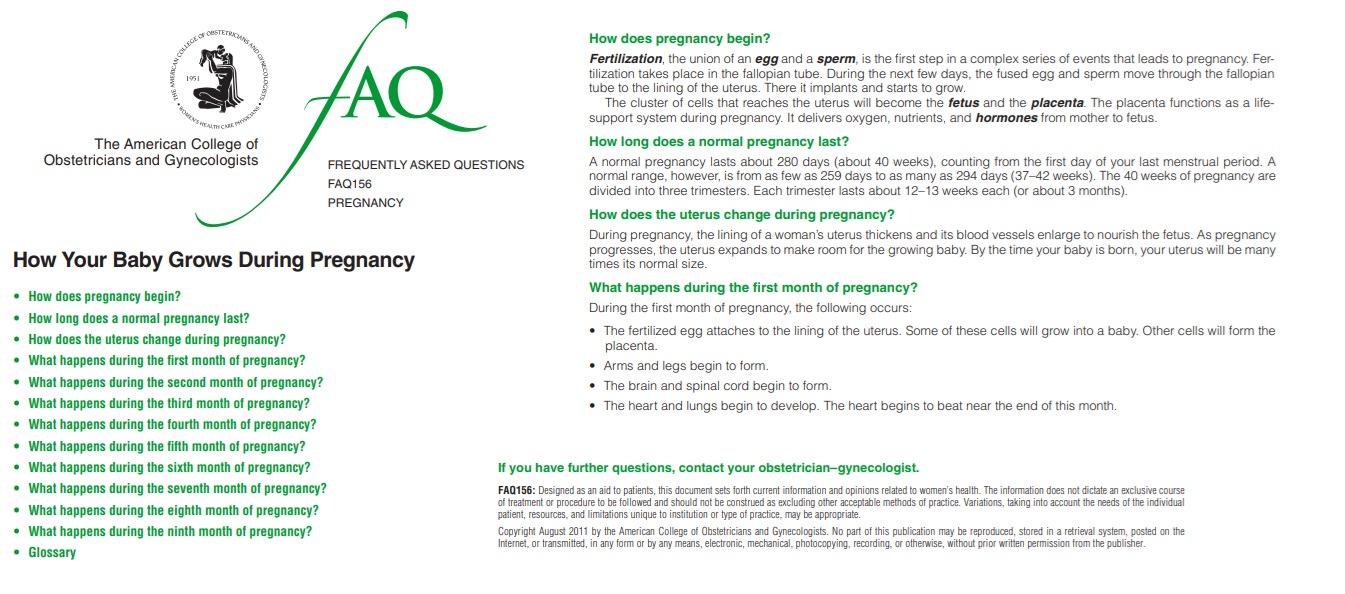
ACOG 2011 document says life begins at fertilization and the fetal heartbeat starts first month of pregnancy
2015: ACOG published the book “Your Pregnancy and Childbirth Month to Month, Sixth Edition,” where it documented that for Week 6 of pregnancy, “Your baby’s heart is beating approximately 105 times per minute…” (photo below).
A practice bulletin on “early pregnancy loss” published by ACOG in 2015 reiterated the fact that a heartbeat is a sign of life for the preborn child in the womb.
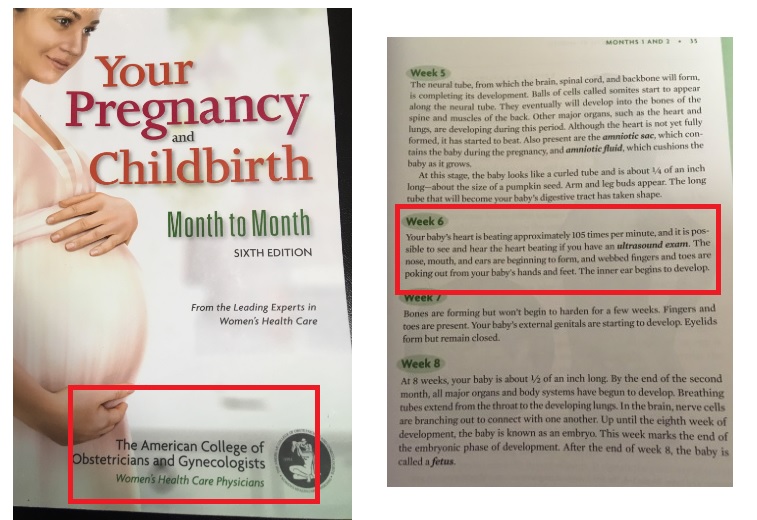
ACOG book says fetal heartbeat beating at 6 weeks
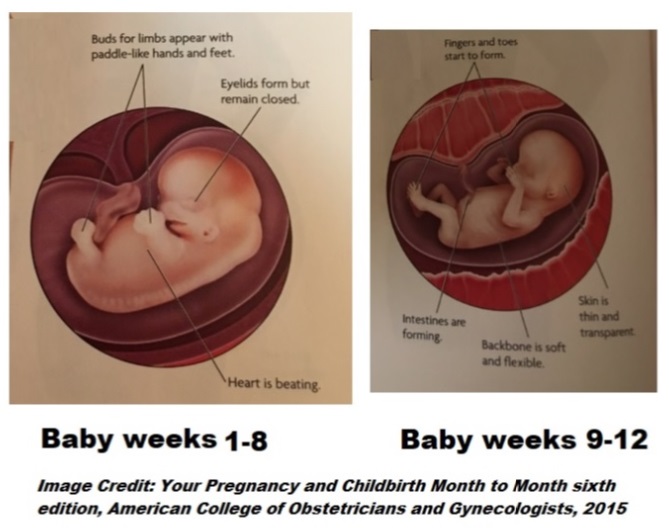
ACOG book on pregnancy
2017: As recently as December of 2017, ACOG’s FAQ, “Prenatal Development: How Your Baby Grows During Pregnancy,” also specified that from 5-8 weeks of pregnancy “The tissues that will form the heart begin to beat. The heartbeat can be detected during an ultrasound exam at about 6 weeks of pregnancy.”
Newer versions changed the word baby to fetus and now claim that from weeks 1-8 of pregnancy, “Cardiac tissue starts to develop.”
2021: ACOG’s Seventh Edition of the Your Pregnancy and Childbirth book claimed that by week six, “parts of the face are taking shape now, including the eyes and nostrils,” and that “Cardiac activity can sometimes be seen during an ultrasound exam this week.”
2022: ACOG’s March 2022 Guide to Language and Abortion claimed that fetal heartbeat detection took place around 17-20 weeks. “Until the chambers of the heart have been developed and can be detected via ultrasound (roughly 17-20 weeks of gestation), it is not accurate to characterize the embryo’s or fetus’s cardiac development as a heartbeat,” an archived page of ACOG’s 2022 language guide, still published on the group’s website as late as September 2023, stated.
2023: ACOG quietly updated its website to a September 2023 language guide which specified that “Fetal cardiac development, like all gestational development, is a gradual process that continues through a pregnancy. Until the chambers of the heart have been developed, it is not accurate to characterize the embryo or fetus’s cardiac development as a heartbeat.”
Note that the new guide leaves out when “fetal cardiac development” begins.
At National Review, Mills called ACOG out for quietly deleting “its grossly inaccurate claim from its ideological ‘Guide to Language and Abortion'” and for “never publicly retract[ing] this statement or provid[ing] an explanation for how it got basic scientific facts so wrong — and misled courts in the process.”
“How did this happen?” Mills asked, adding, “The answer is simple and echoed in other medical debates: when it comes to controversial policy issues, medical interest groups like ACOG put their politics over science.”

